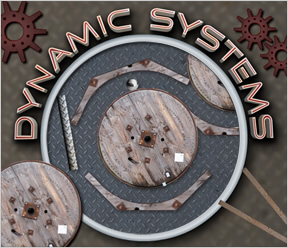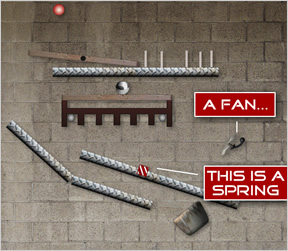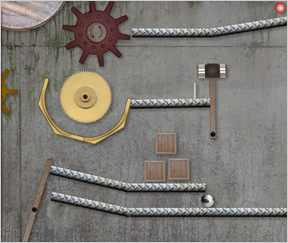![]()
 Let's see, a physics-based puzzle game where you must help a ball find its way to a goal. Where have we seen this before?
Let's see, a physics-based puzzle game where you must help a ball find its way to a goal. Where have we seen this before?
Yes, Dynamic Systems, created by Lorenzo Nuvoletta, is another in a long line of games first made popular by The Incredible Machine, where you must fabricate an overly elaborate system of simple machines to perform a task that would hardly impress a toddler: putting a ball in a bucket. In each level, you're given a silver ball, a bucket, and an assortment of objects with which to exert your domination! OK, domination might be a bit of an overstatement considering you're performing what amounts to an ostentatious computer simulation of clean up time, but if that's not a task you're capable of dominating, you might want to stick with banging pegs into holes for just a bit longer.
 Most of the objects in Dynamic Systems are static, meant to change the path of the ball without introducing any additional momentum. Deflections and elastic collisions are par for he course, and gravity is very much your friend. To help you find just the right path, the angles of all of the objects can be fine-tuned It's also quite refreshing to be given curved sections of track to play with, as these can redirect the ball without stealing too much momentum. Each level also usually contains some sort of moving device (pendulums, springs, wheels, etc), but rarely does the player have any control over the placement of these. Once you've mastered all 40 levels, you can design your own with the built-in level editor.
Most of the objects in Dynamic Systems are static, meant to change the path of the ball without introducing any additional momentum. Deflections and elastic collisions are par for he course, and gravity is very much your friend. To help you find just the right path, the angles of all of the objects can be fine-tuned It's also quite refreshing to be given curved sections of track to play with, as these can redirect the ball without stealing too much momentum. Each level also usually contains some sort of moving device (pendulums, springs, wheels, etc), but rarely does the player have any control over the placement of these. Once you've mastered all 40 levels, you can design your own with the built-in level editor.
Analysis: One feature that makes Dynamic Systems great is that each placeable object can be rotated to any angle you might wish. However, one feature that makes Dynamic Systems frustrating is that each placeable object can be rotated to any angle you might wish. For a relatively simple system, the fine-tuning works beautifully, but if you've got an elaborate contraption, the number of possible configurations quickly approaches absurdity, and it can be frustrating to have to readjust every part of a system just to gain those few extra pixels of distance. Luckily, most levels are designed with a specific solution in mind that doesn't require precision positioning to achieve. Whether or not you recognize the intended solution is another story altogether. In fact, shortcuts abound, as they inevitable must in a game such as this. However, rather than forcing the player to take the long way 'round by placing barriers across these shortcuts, the author elegantly solves the problem by awarding more points for longer solutions, leaving the player simultaneously satisfied at solving the level while still wondering if maybe they could have done better.
 What makes Dynamic Systems stand out among other games of its kind, though, is the fluidity of movement and the sleek graphical design. Its worn-out industrial feel recalls and improves upon that of Collider, and the comparison is even more favorable when you consider the physics. It's like watching mercury race molasses down a waterslide! Yet, the physics aren't over-responsive either. They just feel right. You can nit-pick about the interface if you want (the parts menu should be mouse-overable), but overall, you'd be hard-pressed to name another Flash game that so successfully blends visual design and pleasing physics.
What makes Dynamic Systems stand out among other games of its kind, though, is the fluidity of movement and the sleek graphical design. Its worn-out industrial feel recalls and improves upon that of Collider, and the comparison is even more favorable when you consider the physics. It's like watching mercury race molasses down a waterslide! Yet, the physics aren't over-responsive either. They just feel right. You can nit-pick about the interface if you want (the parts menu should be mouse-overable), but overall, you'd be hard-pressed to name another Flash game that so successfully blends visual design and pleasing physics.
So, although the gameplay treads well-worn paths, its unshakable foundations of good game design make Dynamic Systems a worthy addition to an established line of great games.






Walkthrough Guide
(Please allow page to fully load for spoiler tags to be functional.)
Dynamic Systems Walkthrough
These solutions will get the ball to the bucket, however not all of them will get you the most points. Also due to the way the physics work in this game these solutions may take a couple tries to work. Even some of these solutions didn't work every time, but they do work.
Level 1
Level 2
Level 3
Level 4
Level 5
Level 6
Level 7
Level 8
Level 9
Level 10
Level 11
Level 12
Level 13
Level 14
Level 15
Level 15
Level 16
Level 17
Level 18
Level 19
Level 20
Level 21
Level 22
Level 23
Level 24
Level 25
Level 26
Level 27
Level 28
Level 29
Level 30
Posted by: Kero |
June 18, 2009 3:20 AM
|
June 18, 2009 3:20 AM